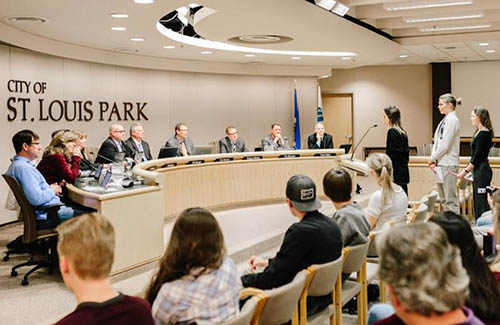A page on St. Louis Park’s website encourages residents to participate in the city’s Climate Action Plan and offers ideas on how to contribute. “Use LED bulbs and a smart thermostat. Choose alternative transportation, such as public transit or RideSharing...”
Local officials will be the first to tell you where the Climate Action Plan, which was adopted in 2018, got its start – with students.
 “The climate crisis will have a huge impact on our future,” Class of 2018 student Lukas Wrede wrote the city on behalf of the St. Louis Park High Roots and Shoots Club and iMatter. “An inadequate response now will cause dangerous economic and environmental disruptions, many of which are already being felt around the globe.”
“The climate crisis will have a huge impact on our future,” Class of 2018 student Lukas Wrede wrote the city on behalf of the St. Louis Park High Roots and Shoots Club and iMatter. “An inadequate response now will cause dangerous economic and environmental disruptions, many of which are already being felt around the globe.”
The letter went on to challenge the city to imagine a new future, one with “clean, renewable energy, non-polluting forms of transportation, minimized waste and a renewed appreciation of our reliance on nature.”
Climate Action Plan takes shape
The city responded, adopting a robust plan that charts a course toward carbon neutrality by 2040. Its mid-term goals:
-
Reduce energy consumption in commercial buildings by 30%
-
New construction should be net-zero energy
-
Reduce energy consumption in residential buildings by 35%
-
Achieve 100% renewable electricity
-
Reduce vehicle emissions by 25%
-
Reduce solid waste by 50%
“The hard part lies ahead — doing the work to achieve these ambitious goals,” said Mayor Jake Spano. “We’ll look to these students to continue to bring their passion, work ethic and values to this ongoing effort, alongside city staff, members of the Environment and Sustainability Commission, local businesses and residents.”
Toward carbon neutrality
Spano says they’re off to a good start:
-
Moving toward renewable energy sources in city buildings and for other uses
-
Moving toward electric vehicles and equipment
-
Mobility Plan that prioritizes walking first, followed by biking, transit and motor vehicle use, respectively
-
Requiring electric vehicle facilities at new developments
-
Housing programs, such as “Live Where You Work” that facilitate affordable housing, shorter commutes and alternative transportation
-
Green building policy for redevelopment
-
Promoting development that is walkable, mixed-use and transit-oriented
-
Integrating health and safety into the city’s 2040 Comprehensive Plan
“The city is and has for a long time been recognized for facing and tackling challenges head-on and inviting innovation,” said Spano. “This is one more example of active and engaged public officials and residents, including those who reflect the values of our past, present and future.”